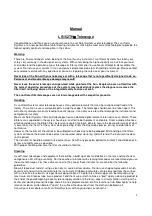
3
Okay let's get started...
Note:
- The telescope is shipped with the dovetail and sol searcher removed for safety during shipping. We
recommend that you use an exact type knife to modify the foam insert as required after you have setup the solar
scope and you are happy with the placement of the rings and the sol searcher.
- The telescope can be transported by careful hand carrying in the case with these items attached. However, we
strongly recommend that these items be removed for transportation via commercial carrier.
- During shipping the tension screw of the feather touch focuser may become loose. Simply tighten the screw as
required or refer to the Starlight Instruments instructions that are provided.
Safety First!
- Always check any telescope before use. Do not use any telescope or filter that appears to be damaged.
Verify that all glass and filters are in place.
- The Blocking Filter diagonal or extension tube must always be used with the Lunt telescope or filter.
So you have your LS152THa setup on a mount. Let's take a look!
Place a ~25mm eyepiece in the focus end so you have the largest field of view to look at.
Pull the diagonal slide tube out about 50mm. Put the focus tube at about 50% of travel.
If you do not have a Sol Searcher you can use the shadow cast by the Sun on the front objective cell against the
clamshell. Center one on the other and you should be close. Look thru the eyepiece. Do you see a fuzzy red
ball? If not, make sure you have removed the dust cap from the front. Try to re-align the Sol Searcher and look
again. After some trial and error the Sun should appear in the eyepiece. Once the Sun is centered now is a good
time to adjust that Sol Searcher.
Focus:
It is amazing how many people walk up to a solar telescope and take a quick look thru without ever
focusing. Course focus is achieved by moving the diagonal drawtube in and out. Medium focus is achieved using
the larger silver knobs on either side of the focuser assembly. Fine focus is achieved with the 10:1 reduction
(smaller gold knob). The fine focus is often too fine for visual use, but comes in very handy if you are imaging.
Focus so that the edge of the Sun is as sharp as possible.
Tuning:
On the side of the scope is a large black cylinder. This cylinder is the tuning system for the H-alpha
filter. Now we will describe how to bring 656.28nm wavelength on band. The black handle of the cylinder system
has a 4 start thread attaching it to the brass cylinder body. Unscrew the black handle completely and carefully
pull the piston from the cylinder. There may be some resistance and a faint pop as the air enters the cylinder.
This is normal. This has reset the system for your altitude. Carefully re-thread the handle onto the body and
engage the threads about one turn. While looking thru the eyepiece gently turn the black handle onto the
cylinder body. There will be little resistance at first, but as the pressure in the cylinder builds the resistance will
increase slightly. As you turn the cylinder you should see features come into view thru the eyepiece. Continued
turning will result in the wavelength shifting thru 656.28nm and detail will begin to disappear. Fine-tune the
cylinder for the best performance.
A few details regarding the pressure tune system. The amount of pressure being supplied to the etalon cavity is
minimal. It is the equivalent of going from -150m below sea level to about 3,000m. Or around 0.1 Bar, there is no
risk of explosion. We are dealing with only a fraction of 1 atmosphere. When not in use we recommend that you
release the pressure by simply backing off the black handle from the cylinder body. If the system unthreads
completely, simply thread it back on 1 turn. It is not necessary to re-set the system every time it is used. Re-
setting may only be required if the system has been sitting for a long period of time.
Re-Focus:
When you feel you have tuned effectively, re-focus the telescope. The finer details should come into
view. Try to relax the eye while observing and let the details come to you.
Change the eyepiece:
When you have a good feel for observing at lower magnifications try to increase the
magnifications in small steps. Place an interesting artifact in the center of the field. Replace the 25mm with a 8 -
12mm eyepiece. Look thru the eyepiece and re-focus carefully. The image has dimmed slightly due to higher
magnification but the details should be easier to see. You can push the magnification as seeing conditions allow.















